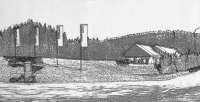Graz, Austria
In 1996, Esther Shalev-Gerz and Jochen Gerz won an international competition launched by the Austrian government to pay tribute to those who opposed the Nazi regime. The artists proposed installing four white flags carrying red inscriptions (“Courage is punished by death,” “The soldier’s fiancee is barbarism,” etc.) on the site at Feliferhof where a great many members of the resistance were shot between 1941 and 1945. After the initial twelve months the artists proposed that the flags would be replaced annually with new texts suggested by soldiers of the Austrian Army. The project was rejected by the Austrian Army and was never implemented. The rejection of The Geese of Feliferhof fuelled a national debate and the polemics were widely reported in the press, which took the matter up several years running.
Graz, Austria
In 1996, Esther Shalev-Gerz and Jochen Gerz won an international competition launched by the Austrian government to pay tribute to those who opposed the Nazi regime. The artists proposed installing four white flags carrying red inscriptions (“Courage is punished by death,” “The soldier’s fiancee is barbarism,” etc.) on the site at Feliferhof where a great many members of the resistance were shot between 1941 and 1945. After the initial twelve months the artists proposed that the flags would be replaced annually with new texts suggested by soldiers of the Austrian Army. The project was rejected by the Austrian Army and was never implemented. The rejection of The Geese of Feliferhof fuelled a national debate and the polemics were widely reported in the press, which took the matter up several years running.

